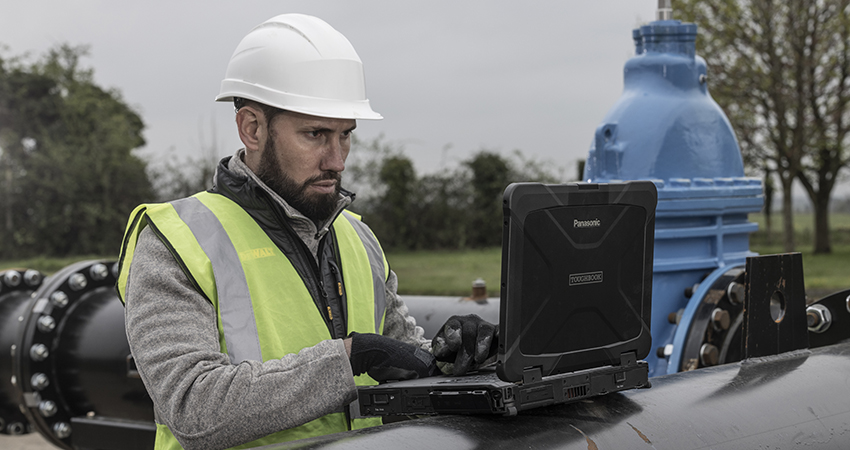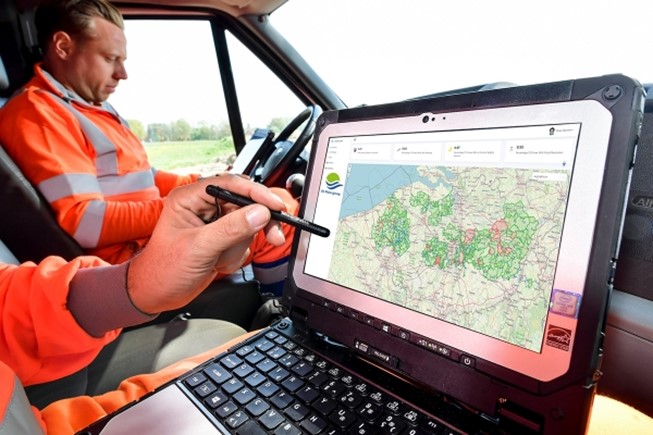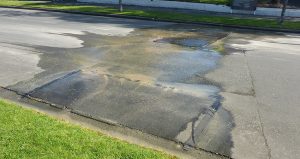Water leakage reduction starts with a robust tool

-
 Editorial Team
Editorial Team
Share article:
European Member States are required to reduce water leakages. According to the Drinking Water Directive water leakage levels must be assessed by all Member States and reduced if they are above a certain threshold. This is seen as a major challenge, largely because most of Europe’s water infrastructure is aging. When looking to reduce leakages, productivity and efficiency is important. A robust device like TOUGHBOOK from Panasonic, that can be used in every environment, can be a key enabling tool in increasing efficiency and productivity for leakage detection teams.
European Sales Strategy Manager Nick Miller from the United Kingdom and Sales Manager Tom Lauwers from Belgium have both been working for a number of years in the water utility sector. Miller: “Accuracy is crucial when detecting and resolving leaks. Operators rely on devices that have a high level of GPS accuracy to map pipework and leaks. Panasonic TOUGHBOOKS provide this. When a leak occurs an engineer needs to be able to confidently locate the leak as quickly as possible. This combination of speed and accuracy can help organisations save water.” In the UK, water companies like Scottish Water, Yorkshire Water and Severn Trent have all successfully used TOUGHBOOK devices.

Saving technical staff
Lauwers adds that Belgium water utilities, like Pidpa, De Watergroep and SWDE, are also satisfied with TOUGHBOOK because it helps their business improve productivity and efficiency, “By using the TOUGHBOOK device they can go quickly to a location to repair for example a broken water pipe. Engineers can report and include photographs to instruct colleagues who need to do the final repair. This efficient procedure is saving the technical staff a lot of time. Nowadays that is extremely important, because technical staff is scarce.”
Advantages
TOUGHBOOK devices are designed to operate in difficult environments. The devices have ingress protection, screen technology to be used in all weather conditions, long battery life and industry leading connectivity. “We are constantly in contact with our customers to understand what improvements we can make to our devices. End user feedback is critically important in our research and design process. Recently we added an extra configuration button on the right side of our device because engineers needed this to easily take landscape photos of a leak. Whilst this might seem minor, small improvements, they can make a user’s life much easier”, says Miller.
Essential device
The significance of a reliable device cannot be overstated. When a device fails, it disrupts productivity and results in work loss. This is precisely why we maintain an exceptionally low failure rate. A dependable device is an indispensable tool—one that gives confidence in its users. In an industrial setting, relying on consumer-grade devices is not ideal, as it not only increases the likelihood of failures but also escalates downtime. It’s crucial to recognize that a malfunctioning device directly translates to a loss of productivity”, explains Lauwers.
Repairing is key
Sustainable products are a priority for Panasonic that produces TOUGHBOOK. Miller: “That is why we prefer to repair our devices for as long as possible. With swappable batteries, our customers are able to simply replace an old battery as opposed to replacing the whole device. A TOUGHBOOK can be used for 5 years or even more. Standard warranty is 3 years with the option of 5 years, and even after the product goes end-of-life we guarantee spare parts for a at least 5 years.. Understanding that the manufacturing process of an IT device contributes to roughly 80% of its carbon footprint enables organizations to significantly reduce their IT CO2 emissions. Extending the replacement cycle of hardware from 2-3 years to 5-6 years can effectively halve CO2 emissions.
Wastewater market
In the UK and Belgium many drinking water companies are already using the robust TOUGHBOOK device. “We would like to expand our activities to the wastewater market”, tells Lauwers. He adds: “The characteristics of TOUGHBOOK are ideal for sewers and Wastewater Treatment Plants (WWTP’s).” Sewer leakages can cause pollution of surface water and groundwater which can eventually lead to a breach of the Water Framework Directive.
Expanding in Europe
Organisations in other EU member states such as Italy, France and Netherlands are prime candidates to consider TOUGHBOOK technology. “In Italy the leakage rate is 30 – 40% and the Netherlands is struggling with aging water infrastructure. All these countries could profit from using a robust device that has proven to be a useful tool in an industrial water environment.
Climate change
Due to climate change the leakage rate of water infrastructure is expected to rise. During extreme droughts drinking water pipes can crack and flash floods can damage existing water infrastructures. In other words, climate change will exacerbate the problem meanwhile European rules are becoming stricter. The challenge to comply with the European Drinking Water Directive will therefore become even bigger.















